Self-Healing Performance of Multifunctional Polymeric Smart Coatings
Abstract
1. Introduction
2. Experimental
2.1. Materials and Chemicals
2.2. Loading of Corrosion Inhibitor
2.3. Synthesis of Urea Formaldehyde Microcapsules (UFMCs) and Their Encapsulation
2.4. Characterization of Loaded Nanotubes and Urea Formaldehyde Microcapsules
2.5. Synthesis of Smart Coatings
2.6. Characterization of Smart Coatings
3. Results and Discussion
3.1. Morphological and Structural Analysis
3.2. FTIR Analysis of HNTs, UFMCs, and the Nanocomposite Coatings
3.3. XPS Analysis
3.4. Particle Size Analysis of the Urea Formaldehyde Microcapsules
3.5. Thermal Stability of the Smart Containers and Nanocomposite Coatings
3.6. Self-Release of Inhibitor from Nanocontainers
3.7. Self-Healing Performance of Nanocomposite Coatings
3.8. Corrosion Behavior Evaluation
4. Conclusions
Author Contributions
Acknowledgments
Conflicts of Interest
References
- Xing, X.; Wang, J.; Li, Q.; Hu, W.; Yuan, J. A novel acid-responsive HNTs-based corrosion inhibitor for protection of carbon steel. Colloids Surf. A Physicochem. Eng. Asp. 2018, 553, 295–304. [Google Scholar] [CrossRef]
- Shen, N.Z.; Wei, H.; Wang, Y.; Guo, Z.; Jiang, D.; Zhang, X.; Yan, X.; Zhu, J.; Shao, L.; Lin, H. Advanced micro/nanocapsules for self-healing smart anticorrosion coatings. J. Mater. Chem. A 2015, 3, 469–480. [Google Scholar]
- Lu, H.; Zhang, S.; Li, W.; Cui, Y.; Yang, T. Synthesis of Graphene Oxide-Based Sulfonated Oligoanilines Coatings for Synergistically Enhanced Corrosion Protection in 3.5% NaCl Solution. ACS Appl. Mater. Interfaces 2017, 9, 4034–4043. [Google Scholar] [CrossRef] [PubMed]
- El-Mahdy, G.A. 2,4-Dihydrazino-6-Morpholino-1,3,5-Triaizne (DHMT) and 2,4-Dihydrazino-6-Piperidino-1,3,5-Triaizne (DHPT) as Promising Corrosion Inhibitors of Steel in Acidic Media. Int. J. Electrochem. Sci. 2016, 11, 5459–5472. [Google Scholar] [CrossRef]
- Mahvash, F.; Eissa, S.; Bordjiba, T.; Tavares, A.C.; Szkopek, T.; Siaj, M. Corrosion resistance of monolayer hexagonal boron nitride on copper. Sci. Rep. 2017, 7, 42139. [Google Scholar] [CrossRef]
- Bramfitt, B.L. Carbon and alloy steels. In Mechanical Engineers’ Handbook: Materials and Mechanical Design, 3rd ed.; Wiley: New York, NY, USA, 2007; Volume 1, pp. 25–65. [Google Scholar]
- Moehwald, H.; Shchukin, D.G. Smart nanocontainers as depot media for feedback active coatings. Chem. Commun. 2011, 47, 8730. [Google Scholar]
- Quinet, M.; Neveu, B.; Moutarlier, V.; Audebert, P.; Ricq, L. Corrosion protection of sol–gel coatings doped with an organic corrosion inhibitor: Chloranil. Prog. Org. Coat. 2007, 58, 46–53. [Google Scholar] [CrossRef]
- Gao, X.-Z.; Liu, H.-J.; Cheng, F.; Chen, Y. Thermoresponsive polyaniline nanoparticles: Preparation, characterization, and their potential application in waterborne anticorrosion coatings. Chem. Eng. J. 2016, 283, 682–691. [Google Scholar] [CrossRef]
- Montemor, M.; Montemor, F. Functional and smart coatings for corrosion protection: A review of recent advances. Surf. Coat. Technol. 2014, 258, 17–37. [Google Scholar] [CrossRef]
- Bryant, D.; Greenfield, D. The use of fluorescent probes for the detection of under-film corrosion. Prog. Org. Coat. 2006, 57, 416–420. [Google Scholar] [CrossRef]
- Mazumder, M.A.J.; Nazal, M.K.; Faiz, M.; Ali, S.A. Imidazolines containing single-, twin- and triple-tailed hydrophobes and hydrophilic pendants (CH2CH2NH)nH as inhibitors of mild steel corrosion in CO2–0.5 M NaCl. RSC Adv. 2016, 6, 12348–12362. [Google Scholar] [CrossRef]
- Taylor, P.; Fouda, A.S.; Megahed, H.; Ead, D.M. Desalination and Water Treatment Lanthanides as environmentally friendly corrosion inhibitors of iron in 3.5% NaCl solution. Desalin. Water Treat. 2013, 37–41. [Google Scholar] [CrossRef]
- Fu, Z.; Yan, K.; Rosenberg, A.; Jin, Z.; Crain, B.; Athas, G.; Heide, R.S.V.; Howard, T.; Everett, A.D.; Herrington, D.; et al. Improved Protein Extractionand Protein Identification from Archival Formalin-fixed Paraffin-embedded Human Aortas. Proteom. Clin. Appl. 2013, 7, 217–224. [Google Scholar] [CrossRef] [PubMed]
- Bouklah, M.; Hammouti, B.; Benkaddour, M.; Benhadda, T. Thiophene derivatives as effective inhibitors for the corrosion of steel in 0.5 m H2SO. J. Appl. Electrochem. 2005, 35, 1095–1101. [Google Scholar] [CrossRef]
- Fouda, A.; Al-Sarawy, A.; El-Katori, E.; Fouda, A. Pyrazolone derivatives as corrosion inhibitors for C-steel in hydrochloric acid solution. Desalination 2006, 201, 1–13. [Google Scholar] [CrossRef]
- Rani, B.E.A.; Basu, B.B.J. Green Inhibitors for Corrosion Protection of Metals and Alloys: An Overview. Int. J. Corros. 2012, 2012, 380217. [Google Scholar] [CrossRef]
- Joshi, A.; Abdullayev, E.; Vasiliev, A.; Volkova, O.; Lvov, Y. Interfacial Modification of Clay Nanotubes for the Sustained Release of Corrosion Inhibitors. Langmuir 2013, 29, 7439–7448. [Google Scholar] [CrossRef] [PubMed]
- Zahidah, K.A.; Kakooei, S.; Ismail, M.C.; Raja, P.B. Halloysite nanotubes as nanocontainer for smart coating application: A review. Prog. Org. Coat. 2017, 111, 175–185. [Google Scholar] [CrossRef]
- Shchukin, D.G.; Möhwald, H. Self-Repairing Coatings Containing Active Nanoreservoirs. Small 2007, 3, 926–943. [Google Scholar] [CrossRef] [PubMed]
- Shchukina, E.; Shchukin, D.; Grigoriev, D. Halloysites and mesoporous silica as inhibitor nanocontainers for feedback active powder coatings. Prog. Org. Coat. 2018, 123, 384–389. [Google Scholar] [CrossRef]
- Nazeer, A.A.; Madkour, M. Potential use of smart coatings for corrosion protection of metals and alloys: A review. J. Mol. Liq. 2018, 253, 11–22. [Google Scholar] [CrossRef]
- Abdullayev, E.; Lvov, Y. Clay nanotubes for corrosion inhibitor encapsulation: Release control with end stoppers. J. Mater. Chem. 2010, 20, 6681–6687. [Google Scholar] [CrossRef]
- Lang, S.; Zhou, Q. Synthesis and characterization of poly(urea-formaldehyde) microcapsules containing linseed oil for self-healing coating development. Prog. Org. Coat. 2017, 105, 99–110. [Google Scholar] [CrossRef]
- Nawaz, M.; Yusuf, N.; Habib, S.; Shakoor, R.A.; Ubaid, F.; Ahmad, Z.; Kahraman, R.; Mansour, S.; Gao, W. Development and Properties of Polymeric Nanocomposite Coatings. Polymers 2019, 11, 852. [Google Scholar] [CrossRef] [PubMed]
- Fix, D.; Andreeva, D.V.; Lvov, Y.M.; Shchukin, D.G.; Möhwald, H. Application of Inhibitor-Loaded Halloysite Nanotubes in Active Anti-Corrosive Coatings. Adv. Funct. Mater. 2009, 19, 1720–1727. [Google Scholar] [CrossRef]
- Williams, G.; Geary, S.; McMurray, H.; McMurray, H. Smart release corrosion inhibitor pigments based on organic ion-exchange resins. Corros. Sci. 2012, 57, 139–147. [Google Scholar] [CrossRef]
- Khan, A.; Ubaid, F.; Fayyad, E.; Ahmad, Z.; Shakoor, P.A.; Montemor, F.; Kahraman, R.; Mansour, S.; Hassan, M.; Hasan, A.; et al. Synthesis and Properties of Polyelectrolyte Multilayered Microcapsules Reinforced Smart Coatings. J. Mater. Sci. 2019, 54, 12079–12094. [Google Scholar] [CrossRef]
- Mert, B.D.; Yazıcı, B.; Lyon, S.B.; Yazici, B. Electrochemical synthesis of novel conductive polymer and corrosion protection properties on aluminium. Corros. Eng. Sci. Technol. 2013, 48, 506–512. [Google Scholar] [CrossRef]
- Ghazi, A.; Ghasemi, E.; Mahdavian, M.; Ramezanzadeh, B.; Rostami, M.; Mahdavian-Ahadi, M. The application of benzimidazole and zinc cations intercalated sodium montmorillonite as smart ion exchange inhibiting pigments in the epoxy ester coating. Corros. Sci. 2015, 94, 207–217. [Google Scholar] [CrossRef]
- Borisova, D.; Moehwald, H.; Shchukin, D.G. Influence of Embedded Nanocontainers on the Efficiency of Active Anticorrosive Coatings for Aluminum Alloys Part I: Influence of Nanocontainer Concentration. ACS Appl. Mater. Interfaces 2012, 4, 2931–2939. [Google Scholar] [CrossRef]
- Haddadi, S.; Ramazani, S.; Mahdavian, M.; Taheri, P.; Mol, J. Fabrication and characterization of graphene-based carbon hollow spheres for encapsulation of organic corrosion inhibitors. Chem. Eng. J. 2018, 352, 909–922. [Google Scholar] [CrossRef]
- Karekar, S.E.; Bagale, U.D.; Sonawane, S.H.; Bhanvase, B.A.; Pinjari, D.V. A smart coating established with encapsulation of Zinc Molybdate centred nanocontainer for active corrosion protection of mild steel: Release kinetics of corrosion inhibitor. Compos. Interfaces 2018, 25, 785–808. [Google Scholar] [CrossRef]
- Ubaid, F.; Naeem, N.; Shakoor, R.; Kahraman, R.; Mansour, S.; Zekri, A. Effect of concentration of DOC loaded TiO2 nanotubes on the corrosion behavior of smart coatings. Ceram. Int. 2019, 45, 10492–10500. [Google Scholar] [CrossRef]
- Falcón, J.; Batista, F.; Aoki, I.; Aoki, I. Encapsulation of dodecylamine corrosion inhibitor on silica nanoparticles. Electrochim. Acta 2014, 124, 109–118. [Google Scholar] [CrossRef]
- Shchukina, E.; Grigoriev, D.; Sviridova, T.; Shchukin, D. Comparative study of the effect of halloysite nanocontainers on autonomic corrosion protection of polyepoxy coatings on steel by salt-spray tests. Prog. Org. Coat. 2017, 108, 84–89. [Google Scholar] [CrossRef]
- Yang, Q.; He, Y.; Xu, W.; Tang, R.; Zhang, C. pH-Responsive nanovalves based on encapsulated halloysite for the controlled release of a corrosion inhibitor in epoxy coating. RSC Adv. 2015, 5, 90609–90620. [Google Scholar]
- Jafari, A.; Hosseini, S.; Jamalizadeh, E. Investigation of Smart Nanocapsules Containing Inhibitors for Corrosion Protection of Copper. Electrochim. Acta 2010, 55, 9004–9009. [Google Scholar] [CrossRef]
- Price, R.R.; Gaber, B.P.; Lvov, Y. In-vitro release characteristics of tetracycline HC1, khellin and nicotinamide adenine dineculeotide from halloysite; a cylindrical mineral. J. Microencapsul. 2001, 18, 713–722. [Google Scholar] [CrossRef]
- Suryanarayana, C.; Rao, K.C.; Kumar, D. Progress in Organic Coatings Preparation and characterization of microcapsules containing linseed oil and its use in self-healing coatings. Prog. Org. Coat. 2008, 63, 72–78. [Google Scholar] [CrossRef]
- Mamaghani, K.R.; Naghib, S.M. The Effect of Stirring Rate on Electrodeposition of Nanocrystalline Nickel Coatings and their Corrosion Behaviors and Mechanical Characteristics. Int. J. Electrochem. Sci. 2017, 12, 5023–5035. [Google Scholar] [CrossRef]
- Li, R.; Zhu, J.; Zhou, W.; Cheng, X.; Li, Y. Thermal properties of sodium nitrate-expanded vermiculite form-stable composite phase change materials. Mater. Des. 2016, 104, 190–196. [Google Scholar] [CrossRef]
- Trivedi, M.K.; Trivedi, A.B.D.; Branton, A.; Trivedi, D.; Nayak, G.; Bairwa, K.; Jana, S. Spectroscopic Characterization of Disodium Hydrogen Orthophosphate and Sodium Nitrate after Biofield Treatment. J. Chromatogr. Sep. Tech. 2015, 6, 282. [Google Scholar] [CrossRef]
- Thanawala, K.; Khanna, A.S. Development of Self-Healing Coatings Using Encapsulated Linseed oil and Tung Oil as Healing Agents. In Proceedings of the NACE International Corrosion Conference, Vancouver, BC, Canada, March 2016. [Google Scholar]
- González, M.G.; Cabanelas, J.C.; Baselga, J. Applications of FTIR on Epoxy Resins-Identification, Monitoring the Curing Process, Phase Separation and Water Uptake. Infrared Spectrosc.-Mater. Sci. Eng. Technol. 2012. [Google Scholar] [CrossRef]
- Saba, N.; Jawaid, M.; Alothman, O.Y.; Paridah, M.T.; Hassan, A. Recent advances in epoxy resin, natural fiber-reinforced epoxy composites and their applications. J. Reinf. Plast. Compos. 2016, 35, 447–470. [Google Scholar] [CrossRef]
- Vijayan, P.P.; El-Gawady, Y.M.H.; Al-Maadeed, M.A.S.A. A comparative study on long term stability of self-healing epoxy coating with different inorganic nanotubes as healing agent reservoirs. Express Polym. Lett. 2017, 11, 863–872. [Google Scholar] [CrossRef]
- Li, H.; Wang, R.; Hu, H.; Liu, W. Surface modification of self-healing poly(urea-formaldehyde) microcapsules using silane-coupling agent. Appl. Surf. Sci. 2008, 255, 1894–1900. [Google Scholar] [CrossRef]
- Ng, K.-M.; Lau, Y.T.R.; Chan, C.-M.; Weng, L.-T.; Wu, J. Surface studies of halloysite nanotubes by XPS and ToF-SIMS. Surf. Interface Anal. 2011, 43, 795–802. [Google Scholar] [CrossRef]
- Deng, S.; Zhang, J.; Ye, L.; Wu, J. Toughening epoxies with halloysite nanotubes. Polymer 2008, 49, 5119–5127. [Google Scholar] [CrossRef]
- Njoku, D.I.; Cui, M.; Xiao, H.; Shang, B.; Li, Y. Understanding the anticorrosive protective mechanisms of modified epoxy coatings with improved barrier, active and self-healing functionalities: EIS and spectroscopic techniques. Sci. Rep. 2017, 7, 15597. [Google Scholar] [CrossRef]
- Feng, Y.; Cheng, Y.F. An intelligent coating doped with inhibitor-encapsulated nanocontainers for corrosion protection of pipeline steel. Chem. Eng. J. 2017, 315, 537–551. [Google Scholar] [CrossRef]
- Butorac, V.; Simeon, V.; Tomisic, V. Effect of Temperature on UV Spectra of Concentrated NaNO3 Aqueous Solutions. Croat. Chim. Acta 2007, 80, 533–539. [Google Scholar]
- Jiao, L.; Dong, D.; Zheng, W.; Wu, W.; Feng, H.; Shen, C.; Yan, H. Determination of Nitrite Using UV Absorption Spectra Based on Multiple Linear Regression. Asian J. Chem. 2013, 25, 2273–2277. [Google Scholar] [CrossRef]
- Thompson, I.; Campbell, D. Interpreting Nyquist responses from defective coatings on steel substrates. Corros. Sci. 1994, 36, 187–198. [Google Scholar] [CrossRef]
- Cotting, F.; Aoki, I.V. Smart protection provided by epoxy clear coating doped with polystyrene microcapsules containing silanol and Ce (III) ions as corrosion inhibitors. Surf. Coat. Technol. 2016, 303, 310–318. [Google Scholar] [CrossRef]
- Wang, W.; Wang, H.; Zhao, J.; Wang, X.; Xiong, C.; Song, L.; Ding, R.; Han, P.; Li, W. Self-healing performance and corrosion resistance of graphene oxide–mesoporous silicon layer–nanosphere structure coating under marine alternating hydrostatic pressure. Chem. Eng. J. 2019, 361, 792–804. [Google Scholar] [CrossRef]
- Abdelaal, M.M.; Mohamed, S.; Barakat, Y.F.; Derbala, H.A.Y.; Hassan, H.; Al Zoubi, W. N-Aminophthalimide as a Synthon for Heterocyclic Schiff bases: Efficient Utilization as Corrosion Inhibitors of Mild Steel in 0.5 mol.L-1 H2SO4 Solution. Egyptian J. Chem. 2018. [Google Scholar] [CrossRef]
- Hsu, C.H.; Mansfeld, F. Technical Note:Concerning the Conversion of the Constant Phase Element Parameter Y0into a Capacitance. Corrosion 2001, 57, 747–748. [Google Scholar] [CrossRef]
- Siva, T.; Sathiyanarayanan, S. Self healing coatings containing dual active agent loaded urea formaldehyde (UF) microcapsules. Prog. Org. Coat. 2015, 82, 57–67. [Google Scholar] [CrossRef]
- Li, J.; Li, Z.; Feng, Q.; Qiu, H.; Yang, G.; Zheng, S.; Yang, J. Encapsulation of linseed oil in graphene oxide shells for preparation of self-healing composite coatings. Prog. Org. Coat. 2019, 129, 285–291. [Google Scholar] [CrossRef]
- Çömlekçi, G.K.; Ulutan, S. Acquired self-healing ability of an epoxy coating through microcapsules having linseed oil and its alkyd. Prog. Org. Coat. 2019, 129, 292–299. [Google Scholar] [CrossRef]
- Navarchian, A.H.; Najafipoor, N.; Ahangaran, F. Surface-modified poly(methyl methacrylate) microcapsules containing linseed oil for application in self-healing epoxy-based coatings. Prog. Org. Coat. 2019, 132, 288–297. [Google Scholar] [CrossRef]
- Gomes, J.-M.; Bedard, C.; Valtcheva, S.; Nelson, M.; Khokhlova, V.; Pouget, P.; Venance, L.; Bal, T.; Destexhe, A. Intracellular Impedance Measurements Reveal Non-ohmic Properties of the Extracellular Medium around Neurons. Biophys. J. 2016, 110, 234–246. [Google Scholar] [CrossRef] [PubMed]
- Orazem, M.E.; Tribollet, B. Electrochemical Impedance Spectroscopy. In Developments in Electrochemistry: Science Inspired by Martin Fleischmann; Wiley: New York, NY, USA, 2014; pp. 349–365. [Google Scholar]
- Lelidis, I.; Barbero, G. Role of the displacement current on Warburg-type behavior. Phys. Rev. E 2017, 95, 52604. [Google Scholar] [CrossRef] [PubMed]
- Sliem, M.H.; Afifi, M.; Radwan, A.B.; Fayyad, E.M.; Shibl, M.F.; Heakal, F.E.-T.; Abdullah, A.M. AEO7 Surfactant as an Eco-Friendly Corrosion Inhibitor for Carbon Steel in HCl solution. Sci. Rep. 2019, 9, 2319. [Google Scholar] [CrossRef] [PubMed]
- Ubaid, F.; Radwan, A.B.; Naeem, N.; Shakoor, R.; Ahmad, Z.; Montemor, M.; Kahraman, R.; Abdullah, A.M.; Soliman, A.; Ahmed, Z. Multifunctional self-healing polymeric nanocomposite coatings for corrosion inhibition of steel. Surf. Coat. Technol. 2019, 372, 121–133. [Google Scholar] [CrossRef]
- Shchukin, D.G.; Lamaka, S.V.; Yasakau, K.A.; Zheludkevich, M.L.; Ferreira, M.G.S.; Möhwald, H.; Lamaka, S.; Yasakau, K.; Zheludkevich, M. Active Anticorrosion Coatings with Halloysite Nanocontainers. J. Phys. Chem. C 2008, 112, 958–964. [Google Scholar] [CrossRef]
- Zahidah, K.A.; Kakooei, S.; Kermanioryani, M.; Mohebbi, H.; Ismail, M.C.; Raja, P.B. Benzimidazole-loaded halloysite nanotube as a smart coating application. Int. J. Eng. Technol. Innov. 2017, 7, 243–254. [Google Scholar]
- Falcón, J.M.; Sawczen, T.; Aoki, I.V. Dodecylamine-Loaded Halloysite Nanocontainers for Active Anticorrosion Coatings. Front. Mater. 2015, 2, 4464. [Google Scholar] [CrossRef]
- Abdullayev, E.; Price, R.; Shchukin, D.; Lvov, Y. Halloysite Tubes as Nanocontainers for Anticorrosion Coating with Benzotriazole. ACS Appl. Mater. Interfaces 2009, 1, 1437–1443. [Google Scholar] [CrossRef]
- Huang, M.; Yang, J. Salt spray and EIS studies on HDI microcapsule-based self-healing anticorrosive coatings. Prog. Org. Coat. 2014, 77, 168–175. [Google Scholar] [CrossRef]
- Behzadnasab, M.; Mirabedini, S.; Esfandeh, M.; Farnood, R. Evaluation of corrosion performance of a self-healing epoxy-based coating containing linseed oil-filled microcapsules via electrochemical impedance spectroscopy. Prog. Org. Coat. 2017, 105, 212–224. [Google Scholar] [CrossRef]

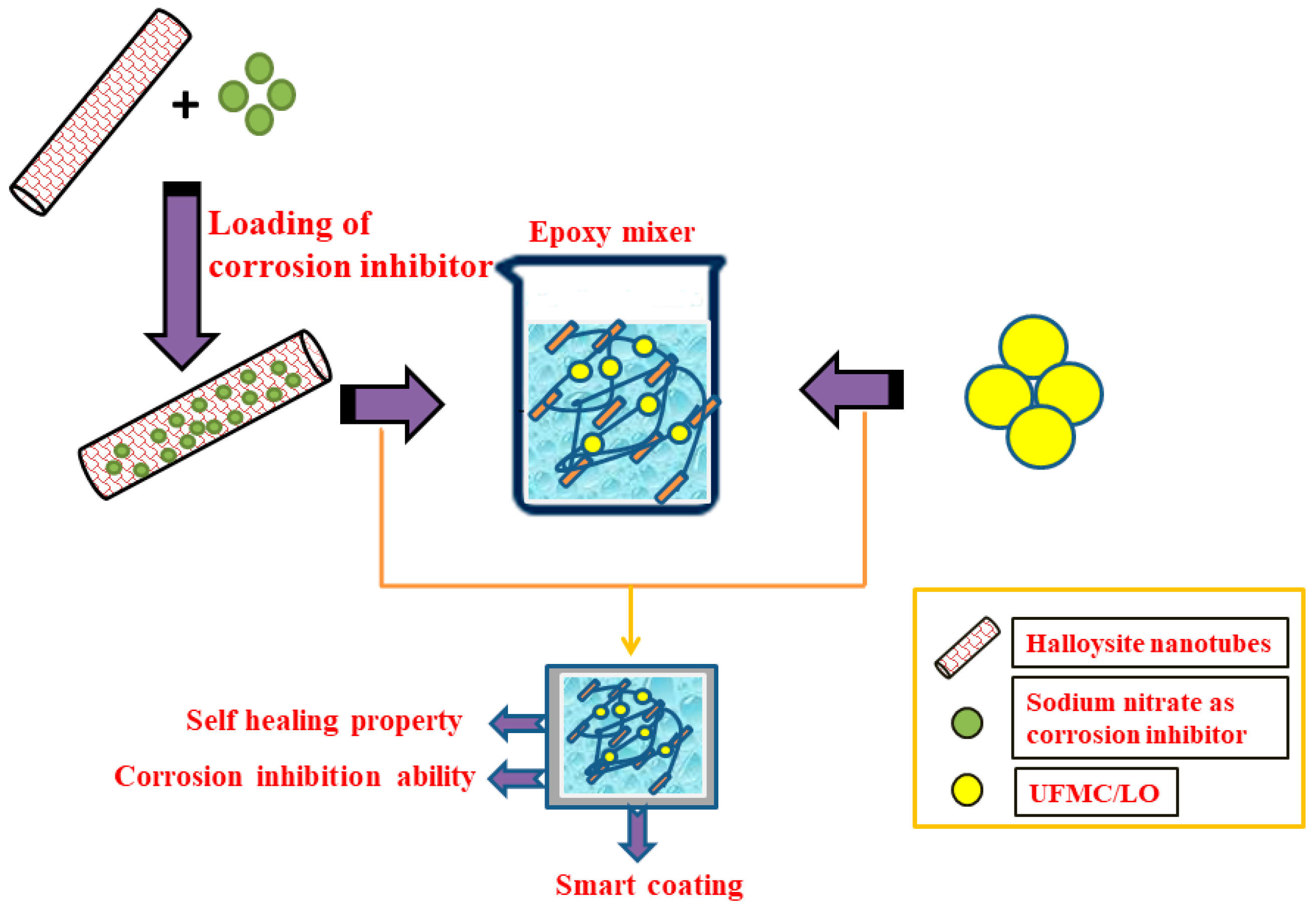

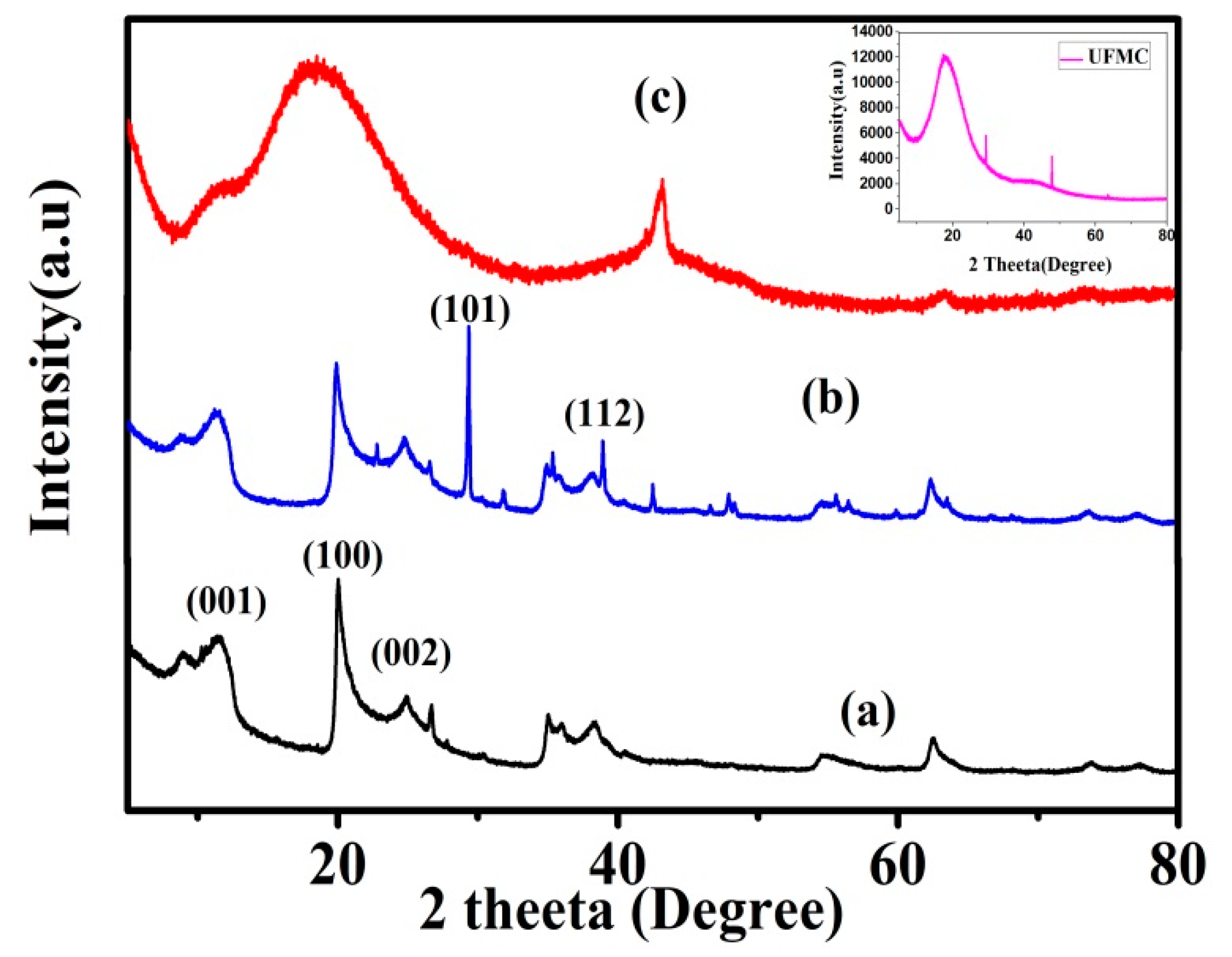
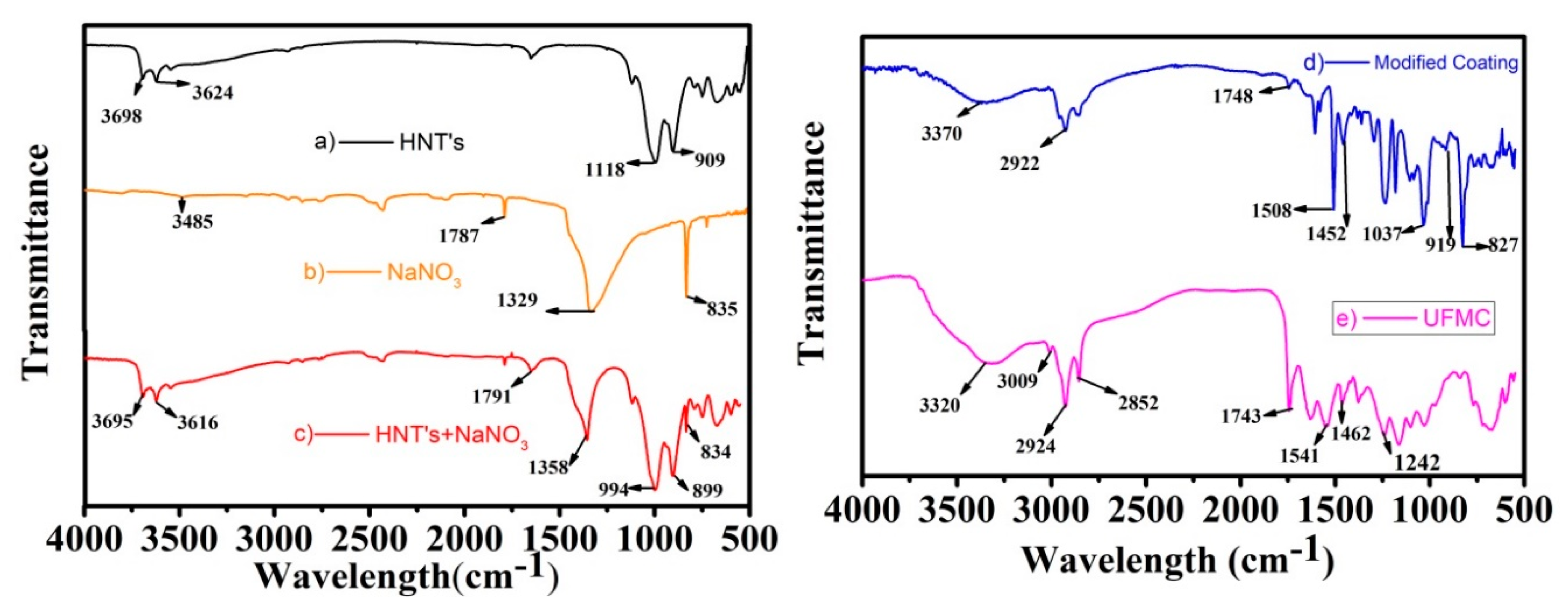
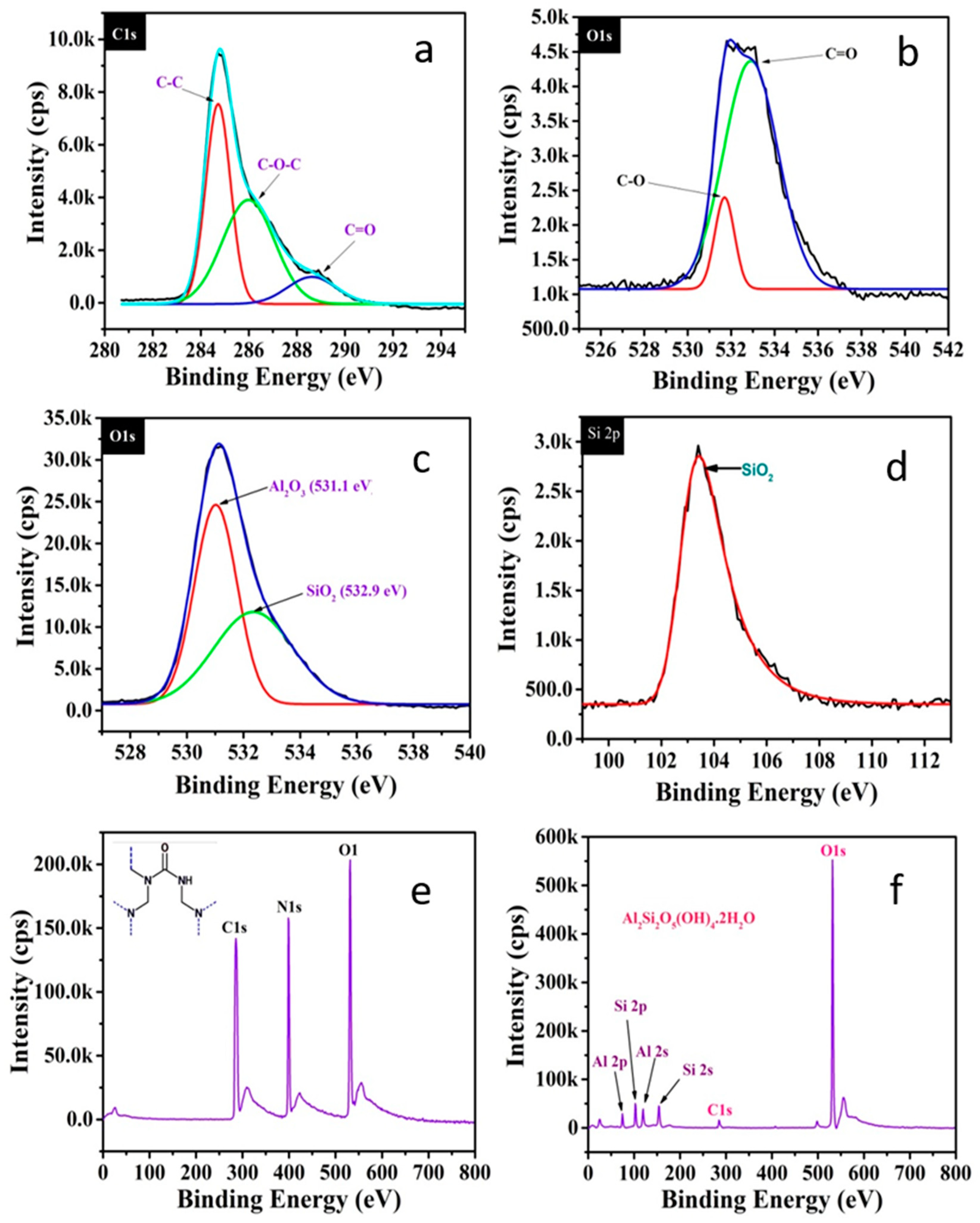
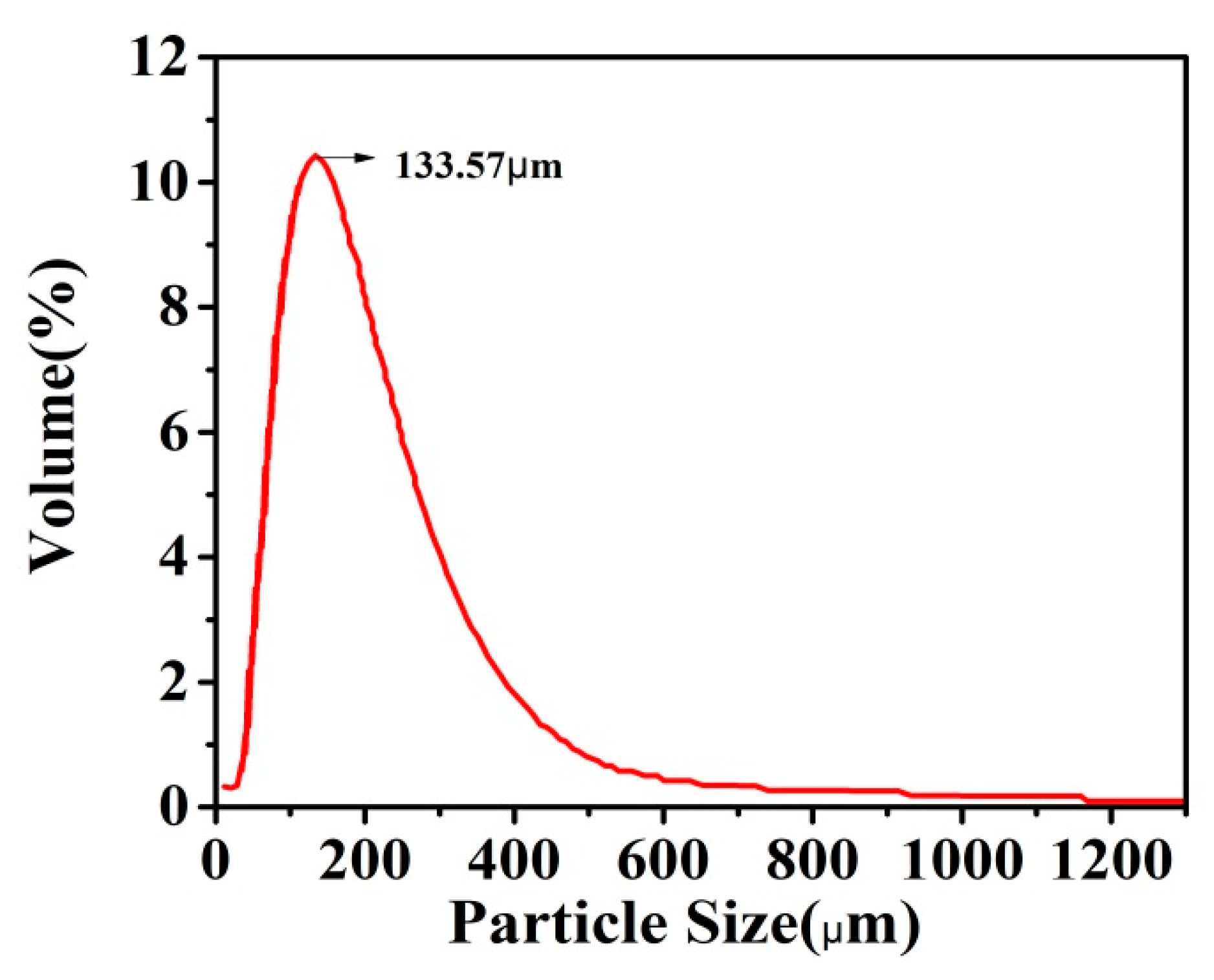
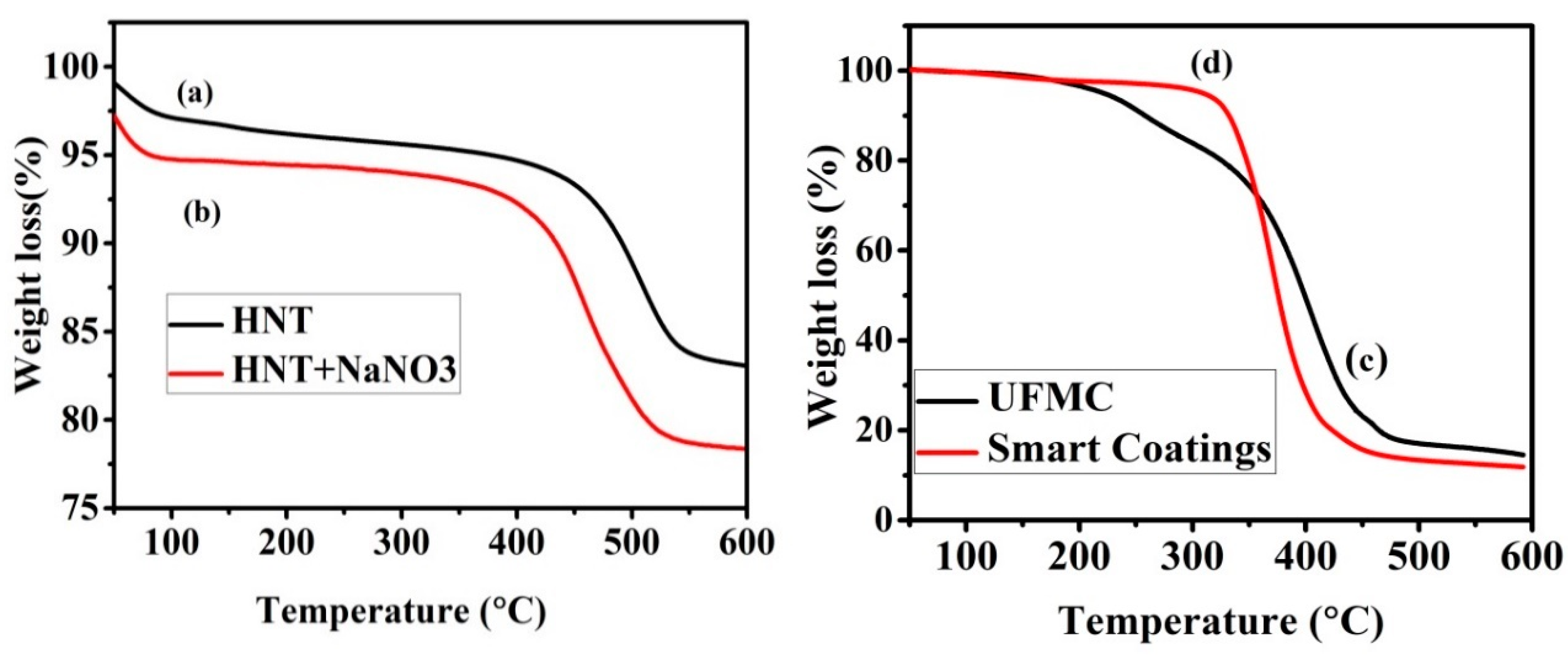

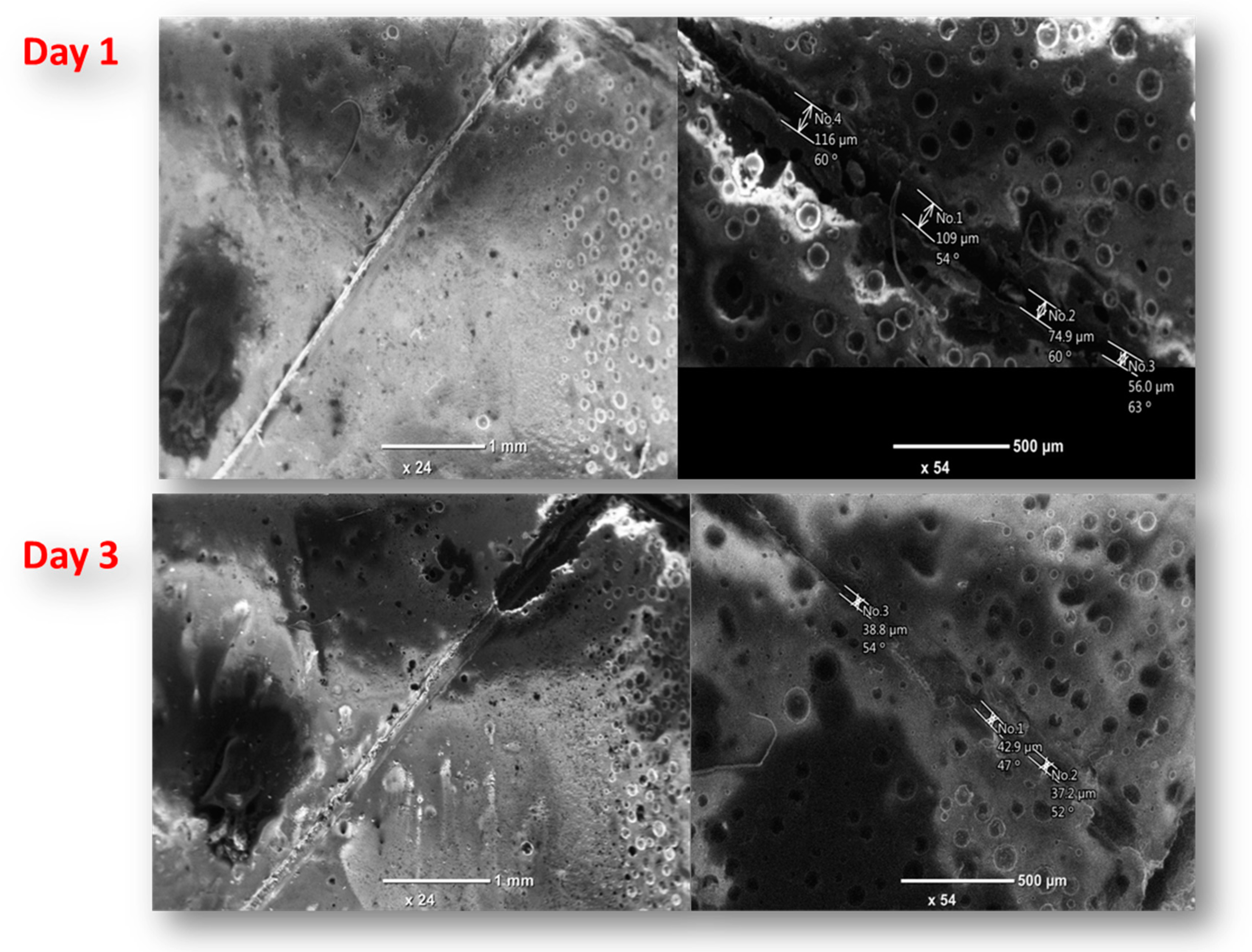
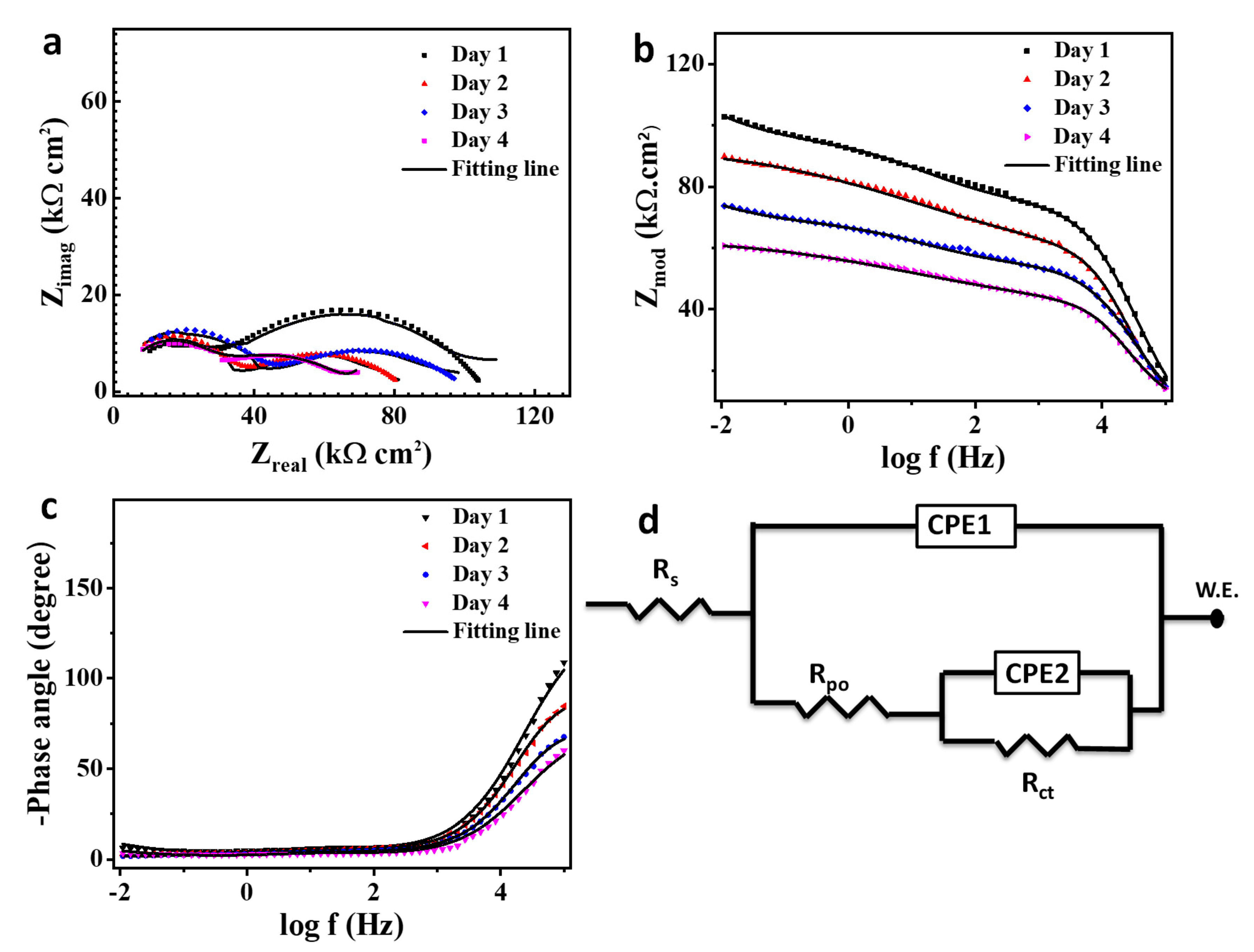
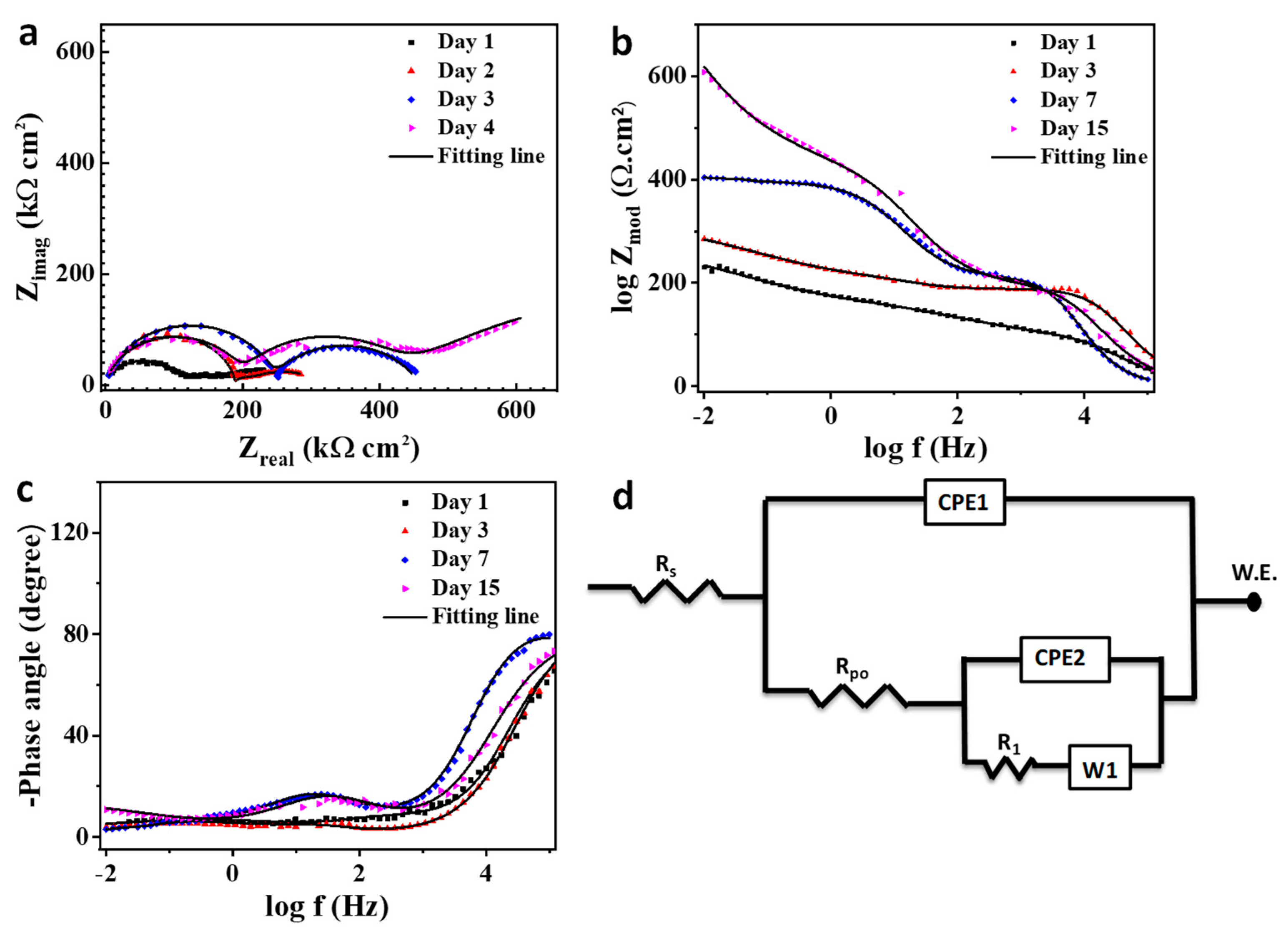
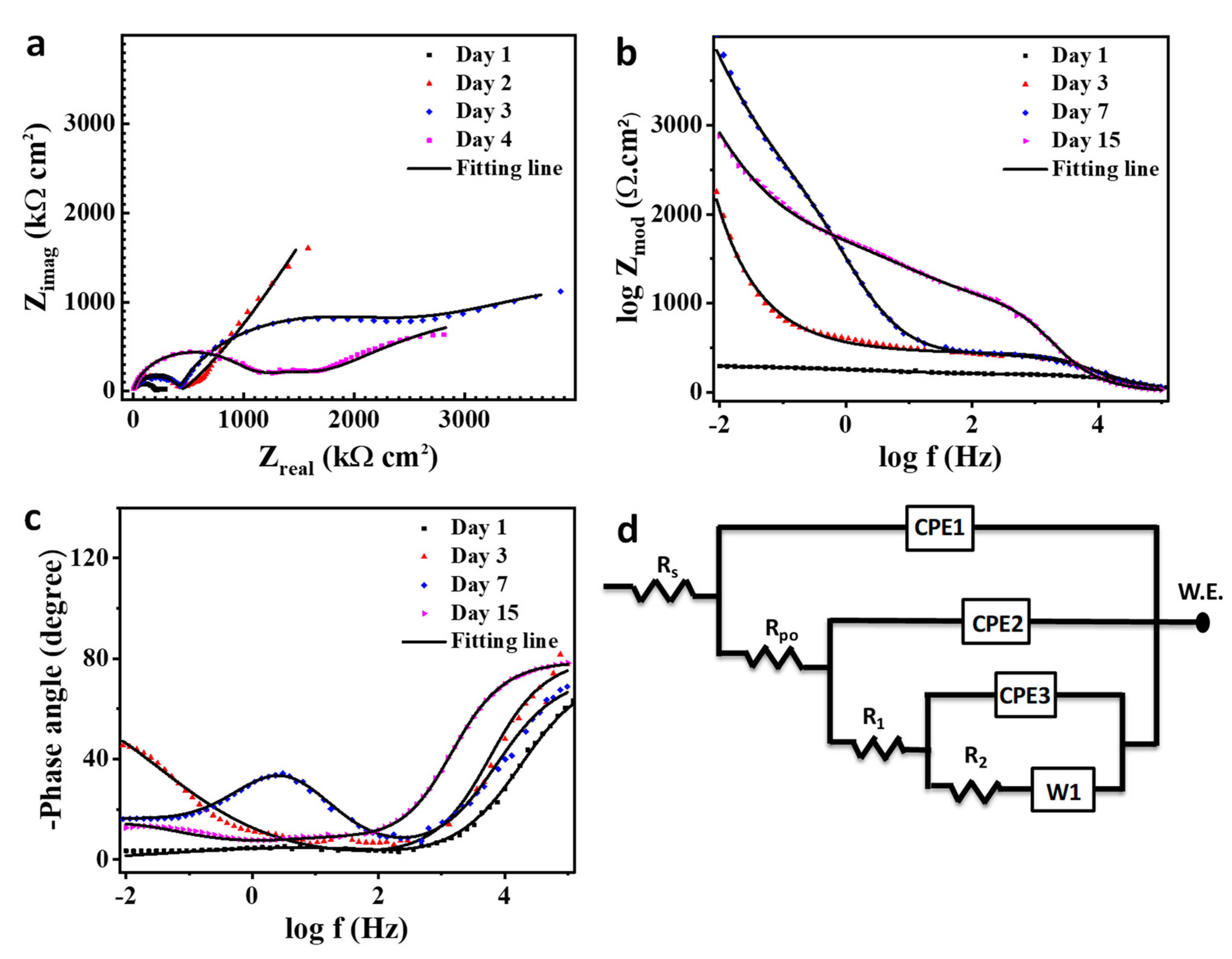
| Size (µm) | 0–4 | 4–63 | 63–125 | 125–250 | 250–500 | 500–1000 | 1000–2000 |
|---|---|---|---|---|---|---|---|
| Volume (%) | 0.64 | 9 | 34.96 | 40.88 | 13.07 | 1.32 | 0.13 |
| Coating | Exposure Time, Days | Rs kΩ cm2 | Rpo kΩ cm2 | Ypo × 10−6 Ω−1 sncm−2 | R1 kΩ cm2 | Y1 × 10−6 Ω−1 sncm−2 | R2 kΩ cm2 | Y2 × 10−9 Ω−1 sncm−2 | W × 10−6 Ω−1 sncm−2 |
|---|---|---|---|---|---|---|---|---|---|
| Pure | 1st | 0.916 | 33.17 | 0.814 | 110.3 | 0.094 | ---- | ---- | ---- |
| 2nd | 0.876 | 39.68 | 0.693 | 98.42 | 0.168 | ---- | ---- | ---- | |
| 3rd | 0.796 | 46.39 | 0.652 | 81.37 | 0.237 | ---- | ---- | ---- | |
| 4th | 0.824 | 36.11 | 0.765 | 73.14 | 0.429 | ---- | ---- | ---- | |
| Plain | 1st | 0.111 | 143.9 | 0.083 | 210.7 | 0.058 | ---- | ---- | 0.677 |
| 2nd | 0.241 | 204.7 | 0.059 | 290.0 | 0.046 | ---- | ---- | 1.34 | |
| 3rd | 0.048 | 231.9 | 0.051 | 401.2 | 0.028 | ---- | ---- | 3.54 | |
| 4th | 0.118 | 191.1 | 0.072 | 550.1 | 0.020 | ---- | ---- | 7.01 | |
| Smart | 1st | 0.179 | 128.19 | 0.965 | 216.92 | 0.093 | ---- | ---- | 1.68 |
| 2nd | 0.116 | 635.2 | 0.011 | 992.3 | 0.006 | 3916.1 | 6.134 | 0.97 | |
| 3rd | 0.156 | 582.4 | 0.016 | 2041.4 | 0.001 | 5651.2 | 2.871 | 3.01 | |
| 4th | 0.164 | 1213.0 | 0.004 | 1648.5 | 0.001 | 34,000 | 7.396 | 2.13 |
© 2019 by the authors. Licensee MDPI, Basel, Switzerland. This article is an open access article distributed under the terms and conditions of the Creative Commons Attribution (CC BY) license (http://creativecommons.org/licenses/by/4.0/).
Share and Cite
Habib, S.; Khan, A.; Nawaz, M.; Sliem, M.H.R.; Shakoor, R.A.; Kahraman, R.; Abdullah, A.M.; Zekri, A. Self-Healing Performance of Multifunctional Polymeric Smart Coatings. Polymers 2019, 11, 1519. https://doi.org/10.3390/polym11091519
Habib S, Khan A, Nawaz M, Sliem MHR, Shakoor RA, Kahraman R, Abdullah AM, Zekri A. Self-Healing Performance of Multifunctional Polymeric Smart Coatings. Polymers. 2019; 11(9):1519. https://doi.org/10.3390/polym11091519
Chicago/Turabian StyleHabib, Sehrish, Adnan Khan, Muddasir Nawaz, Mostafa Hussein Ramadan Sliem, Rana Abdul Shakoor, Ramazan Kahraman, Aboubakr M. Abdullah, and Atef Zekri. 2019. "Self-Healing Performance of Multifunctional Polymeric Smart Coatings" Polymers 11, no. 9: 1519. https://doi.org/10.3390/polym11091519
APA StyleHabib, S., Khan, A., Nawaz, M., Sliem, M. H. R., Shakoor, R. A., Kahraman, R., Abdullah, A. M., & Zekri, A. (2019). Self-Healing Performance of Multifunctional Polymeric Smart Coatings. Polymers, 11(9), 1519. https://doi.org/10.3390/polym11091519











